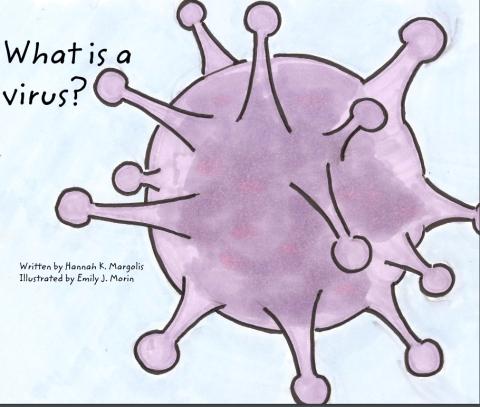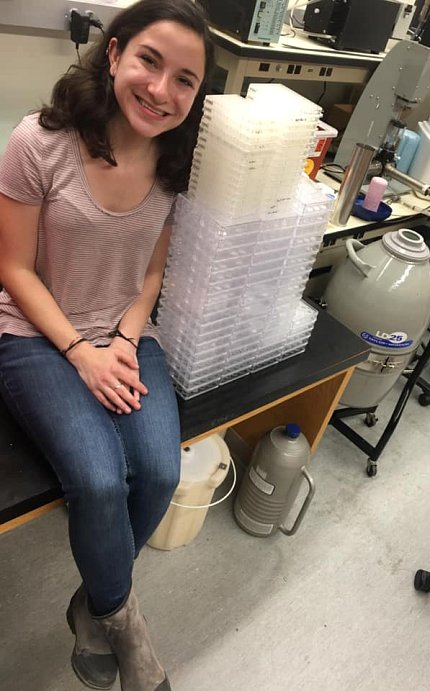Trainee Writes Children’s Book About Viruses

Most of us rarely think about viruses until these microscopic nuisances upend our lives. These past few months have been fraught with confusion and frustration and, as the Covid-19 pandemic rages on, we continue grappling with uncertainties. It’s hard enough for adults to make sense of it all, let alone explaining it to children.
For kids wondering why their school shut down, why everyone is suddenly wearing masks and why they can’t hug grandma, there’s a new resource. Hannah Margolis, a 2020 Dartmouth College graduate who’s now a postbaccalaureate fellow at NIH, has written a children’s book titled What Is a Virus?, available for free online.
“When the pandemic started, I was very frustrated because my school shut down and I knew all these other schools were shutting down as well. So, there were all these kids and families stuck at home who might not necessarily understand why,” said Margolis, who wrote the book as a positive outlet for her frustration in between finishing her Dartmouth coursework remotely.
“I think a lot of the problems we’ve had in the U.S. with people not wearing masks or washing their hands or following other scientific guidelines are partially because people just don’t understand where the advice is coming from, and that makes [covid] really hard to combat. Because you can’t see a virus, it’s really difficult to convince people it’s there.”

Photo: Emily Morin
In the book, illustrated by Dartmouth classmate Emily Morin, Margolis explains how a virus makes us sick and how our bodies can fight back even better if we take care of ourselves. She devoted three pages to proper handwashing. In the colorful spread, she explained that soap destroys the protein and fat outer layer of the virus so it can no longer infect cells.
“Knowing some basic science can really go a long way to help reinforce the safety standards we need to slow down infection rates and get things back to normal,” she said.
Margolis hopes her book will inform people of all ages. She wrote it with younger kids in mind but included informative sidebars—on SARS-CoV-2, DNA/RNA, the history of microscopes, the importance of vaccines—for the more inquisitive older kids. Parents may learn a few things too.

Photo: Emily Morin
The information “is not necessarily difficult to understand,” said Margolis. “It’s just stuff that you might not have heard since high school biology or maybe you didn’t learn it at all. Even as an adult, it can be helpful to have a basic refresher on viruses right now.”
Raised in a small town in Nevada, Margolis writes a regular guest column for her hometown paper, the Elko Daily Free Press. She wasn’t sure if people back home would be interested in the science behind the pandemic, but they were.
“There’s been this incredible public outcry of people wanting to understand this information,” she said. Questions began pouring in, inspiring her to write a series on Covid-19, with topics ranging from wearing masks to herd immunity and her favorite science field, structural biology.

Eager to do some lab work before applying to graduate school, Margolis arrived at NIH as an IRTA fellow and teamed up with Dr. Naoko Mizuno’s lab at NHLBI. The lab had moved to NIH from Germany in January, a few weeks before Covid-19 would suspend lab operations across NIH. Now, they’re busy setting up to get experiments underway. Although Margolis does not work on SARS-CoV-2, the tools and methods used in studying proteins could be applied to viruses.
“It’s really incredible. Proteins are smaller than a wavelength of light, yet they’re responsible for everything that keeps our bodies moving and healthy,” she said. “Being able to see them on a molecular level is very important right now. The structures of the SARS-CoV-2 viral protein are being used to help with drug targeting and trying to determine how to inactivate the virus.”
Margolis wants her book to convey that viruses can be scary, amazing and cool all at the same time.
“I want kids to be excited by this stuff,” she said. Covid-19 “has real implications in the world and we need to take it seriously. But it’s also okay to sit back, enjoy the illustrations and think: virus structures are really cool-looking.”
The free online book is available at https://digitalcommons.dartmouth.edu/cgi/viewcontent.cgi?article=1000&context=student_projects.
